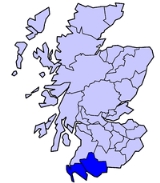
Galloway
Encyclopedia
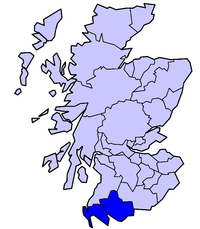
Scotland
Scotland is a country that is part of the United Kingdom. Occupying the northern third of the island of Great Britain, it shares a border with England to the south and is bounded by the North Sea to the east, the Atlantic Ocean to the north and west, and the North Channel and Irish Sea to the...
. It usually refers to the former counties of Wigtownshire
Wigtownshire
Wigtownshire or the County of Wigtown is a registration county in the Southern Uplands of south west Scotland. Until 1975, the county was one of the administrative counties used for local government purposes, and is now administered as part of the council area of Dumfries and Galloway...
(or historically West Galloway) and Kirkcudbrightshire
Kirkcudbrightshire
The Stewartry of Kirkcudbright or Kirkcudbrightshire was a county of south-western Scotland. It was also known as East Galloway, forming the larger Galloway region with Wigtownshire....
(or historically East Galloway). It is part of the Dumfries and Galloway
Dumfries and Galloway
Dumfries and Galloway is one of 32 unitary council areas of Scotland. It was one of the nine administrative 'regions' of mainland Scotland created in 1975 by the Local Government etc. Act 1973...
council area
Council Area
A Council Area is one of the areas defined in Schedule 1 of the Local Government etc. Act 1994 and is under the control of one of the local authorities in Scotland created by that Act.-Legislation :1889...
of Scotland.
Galloway is contained by sea to the west and south, the Galloway Hills
Galloway Hills
The Galloway hills are part of the Southern Uplands of Scotland, and form the northern boundary of western Galloway. They lie within the bounds of Galloway Forest Park, an area of some of largely uninhabited wild land, managed by the Forestry Commission...
to the north, and the River Nith
River Nith
The River Nith is a river in South West Scotland.-Source, flow and mouth:The Nith rises in the Carsphairn hills of East Ayrshire, more precisely between Prickeny Hill and Enoch Hill, 7 km East of Dalmellington...
to the east; the border between Kirkcudbrightshire and Wigtownshire is marked by the River Cree
River Cree
The River Cree is a river in Dumfries and Galloway, Scotland which runs through Newton Stewart and into the Solway Firth. It forms part of the boundary between the counties of Wigtownshire and Kirkcudbrightshire....
.
The definition has, however, fluctuated greatly in size over history. The name is also given to a hardy breed of black, hornless beef
Beef
Beef is the culinary name for meat from bovines, especially domestic cattle. Beef can be harvested from cows, bulls, heifers or steers. It is one of the principal meats used in the cuisine of the Middle East , Australia, Argentina, Brazil, Europe and the United States, and is also important in...
cattle native to the region (and also to the more distinctive 'Belted Galloway
Belted Galloway
The Belted Galloway is a rare beef breed of cattle originating from Galloway in South West Scotland, adapted to living on the poor upland pastures and windswept moorlands of the region...
' or 'Beltie'). Galloway has always been slightly isolated due to having 150 miles (241.4 km) of rugged coastline and a vast range of largely uninhabited hills to the North.
Geography and Landform
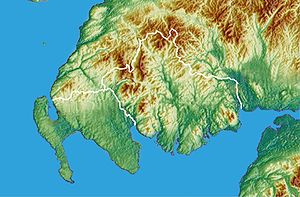
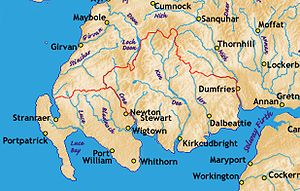
Galloway comprises that part of Scotland southwards from the Southern Upland watershed
Water divide
A drainage divide, water divide, divide or watershed is the line separating neighbouring drainage basins...
and westward from the River Nith. Traditionally it has been described as stretching from "the braes of Glenapp to the Nith". The valleys of three rivers, the Urr Water
Urr Water
Urr Water or River Urr is a river in southwest Scotland.Entirely within Dumfries and Galloway, the Urr Water originates at Glenlair, and flows southwards for thirty miles from Loch Urr to its outflow into the Solway Firth at Rough Firth...
, the Water of Ken
Water of Ken
The Water of Ken is a river in Galloway, south-west Scotland. It rises on Blacklorg Hill, north-east of Cairnsmore of Carsphairn in the Carsphairn hills, and flows south-westward into the Glenkens valley, passing through Carsfad and Earlstoun lochs, both of which are dammed to supply the Galloway...
and River Dee
River Dee, Galloway
The River Dee, in south-west Scotland, flows from its source in Loch Dee amongst the Galloway Hills, firstly to Clatteringshaws Loch, then in to Loch Ken, where it joins the Water of Ken. From there, the Dee flows southwards to Kirkcudbright, and into Kirkcudbright Bay to reach the Solway. The...
, and the Cree, all running north-south, provide much of the good arable land, although there is also some arable land on the coast. Generally however the landscape is rugged and much of the soil is shallow. The generally south slope and southern coast make for mild and wet climate, and there is a great deal of good pasture.
The northern part of Galloway is exceedingly rugged and forms the largest remaining wilderness in Britain
Great Britain
Great Britain or Britain is an island situated to the northwest of Continental Europe. It is the ninth largest island in the world, and the largest European island, as well as the largest of the British Isles...
south of the Highlands
Scottish Highlands
The Highlands is an historic region of Scotland. The area is sometimes referred to as the "Scottish Highlands". It was culturally distinguishable from the Lowlands from the later Middle Ages into the modern period, when Lowland Scots replaced Scottish Gaelic throughout most of the Lowlands...
. This area is known as the Galloway Hills
Galloway Hills
The Galloway hills are part of the Southern Uplands of Scotland, and form the northern boundary of western Galloway. They lie within the bounds of Galloway Forest Park, an area of some of largely uninhabited wild land, managed by the Forestry Commission...
.
Galloway landmarks on Ptolemy's map
The 2nd century geographer PtolemyPtolemy
Claudius Ptolemy , was a Roman citizen of Egypt who wrote in Greek. He was a mathematician, astronomer, geographer, astrologer, and poet of a single epigram in the Greek Anthology. He lived in Egypt under Roman rule, and is believed to have been born in the town of Ptolemais Hermiou in the...
produced a map of Britain in his Geography
Geographia (Ptolemy)
The Geography is Ptolemy's main work besides the Almagest...
, in which he describes the landmarks and peoples of the island. The landmarks were identified long ago, and a number of them relate to Galloway:
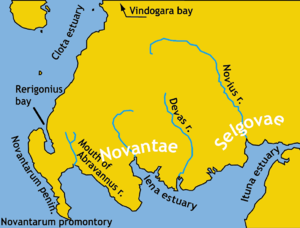
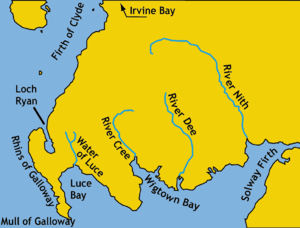
Land use
Historically Galloway has been famous both for horseHorse
The horse is one of two extant subspecies of Equus ferus, or the wild horse. It is a single-hooved mammal belonging to the taxonomic family Equidae. The horse has evolved over the past 45 to 55 million years from a small multi-toed creature into the large, single-toed animal of today...
s and for cattle rearing, and milk
Milk
Milk is a white liquid produced by the mammary glands of mammals. It is the primary source of nutrition for young mammals before they are able to digest other types of food. Early-lactation milk contains colostrum, which carries the mother's antibodies to the baby and can reduce the risk of many...
and beef
Beef
Beef is the culinary name for meat from bovines, especially domestic cattle. Beef can be harvested from cows, bulls, heifers or steers. It is one of the principal meats used in the cuisine of the Middle East , Australia, Argentina, Brazil, Europe and the United States, and is also important in...
production are both still major industries. There is also substantial timber
Timber
Timber may refer to:* Timber, a term common in the United Kingdom and Australia for wood materials * Timber, Oregon, an unincorporated community in the U.S...
production and some fisheries
Fishery
Generally, a fishery is an entity engaged in raising or harvesting fish which is determined by some authority to be a fishery. According to the FAO, a fishery is typically defined in terms of the "people involved, species or type of fish, area of water or seabed, method of fishing, class of boats,...
. The combination of hills and high rainfall make Galloway ideal for hydroelectric power production, and the Galloway Hydro Power scheme was begun in 1929. Since then, electricity generation
Electricity generation
Electricity generation is the process of generating electric energy from other forms of energy.The fundamental principles of electricity generation were discovered during the 1820s and early 1830s by the British scientist Michael Faraday...
has been a significant industry. More recently wind turbine
Wind turbine
A wind turbine is a device that converts kinetic energy from the wind into mechanical energy. If the mechanical energy is used to produce electricity, the device may be called a wind generator or wind charger. If the mechanical energy is used to drive machinery, such as for grinding grain or...
s have been installed at a number of locations on the watershed, and a large offshore wind-power plant is planned, increasing Galloway's 'green energy' production.
Name
It is generally agreed that the name 'Galloway' derives from the name Gall-Gaidel, and indeed the modern and medieval words for Galloway in Gaelic are Gall-Ghàidhealaibh and Gallgaidelaib respectively, "land of the foreign Gaels". The term is not recorded until the 11th century. Daphne Brooke, a popular author of the history of the region, tried to argue for a derivation from the term 'Caleddon', an alleged BrythonicBrythonic languages
The Brythonic or Brittonic languages form one of the two branches of the Insular Celtic language family, the other being Goidelic. The name Brythonic was derived by Welsh Celticist John Rhys from the Welsh word Brython, meaning an indigenous Briton as opposed to an Anglo-Saxon or Gael...
form of the name written in Latin 'Caledonia
Caledonia
Caledonia is the Latinised form and name given by the Romans to the land in today's Scotland north of their province of Britannia, beyond the frontier of their empire...
'. This etymology is almost universally rejected.
Early Galloway
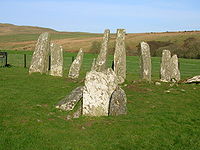
Ancient Rome
Ancient Rome was a thriving civilization that grew on the Italian Peninsula as early as the 8th century BC. Located along the Mediterranean Sea and centered on the city of Rome, it expanded to one of the largest empires in the ancient world....
named the inhabitants of Galloway the Novantae
Novantae
The Novantae were a people of the late 2nd century who lived in what is now Galloway and Carrick, in southwestern-most Scotland. They are mentioned briefly in Ptolemy's Geography The Novantae were a people of the late 2nd century who lived in what is now Galloway and Carrick, in southwestern-most...
. According to tradition, before the end of Roman rule in Britain, St. Ninian established a church at Whithorn
Whithorn
Whithorn is a former royal burgh in Dumfries and Galloway, Scotland, about ten miles south of Wigtown. The town was the location of the first recorded Christian church in Scotland, Candida Casa : the 'White [or 'Shining'] House', built by Saint Ninian about 397.-Eighth and twelfth centuries:A...
which remained an important place of pilgrimage
Pilgrimage
A pilgrimage is a journey or search of great moral or spiritual significance. Typically, it is a journey to a shrine or other location of importance to a person's beliefs and faith...
until the Reformation
Scottish Reformation
The Scottish Reformation was Scotland's formal break with the Papacy in 1560, and the events surrounding this. It was part of the wider European Protestant Reformation; and in Scotland's case culminated ecclesiastically in the re-establishment of the church along Reformed lines, and politically in...
. The county is rich in prehistoric monuments and relics, amongst the most notable of which are the Drumtroddan Standing Stones (and cup-and-ring carvings), the Torhousekie Stone Circle
Torhouse
The Standing Stones of Torhouse are a circle of nineteen granite boulders on the land of Torhouse, three miles west of Wigtown, Scotland.They are set on their ends with three larger stones placed in a line in the middle. This is the only stone circle of its type in the Machars area and is of a...
, and Cairn Holy (a Neolithic Chambered Cairn). There is also evidence of one of the earliest pit-fall traps in Europe which was discovered near Glenluce.
In the west, the city of Rerigonium (literally 'very royal place'), shown on Ptolemy
Ptolemy
Claudius Ptolemy , was a Roman citizen of Egypt who wrote in Greek. He was a mathematician, astronomer, geographer, astrologer, and poet of a single epigram in the Greek Anthology. He lived in Egypt under Roman rule, and is believed to have been born in the town of Ptolemais Hermiou in the...
's map of the world, is a strong contender for the site of Pen Rhionydd
Pen Rhionydd
Pen Rhionydd is named as the location of King Arthur's northern court in a Welsh triad found in Peniarth MS 54, containing pre-Galfridian traditions:...
, referred to in the Welsh Triads
Welsh Triads
The Welsh Triads are a group of related texts in medieval manuscripts which preserve fragments of Welsh folklore, mythology and traditional history in groups of three. The triad is a rhetorical form whereby objects are grouped together in threes, with a heading indicating the point of likeness...
as one of the 'three thrones of Britain' associated with the legendary King Arthur
King Arthur
King Arthur is a legendary British leader of the late 5th and early 6th centuries, who, according to Medieval histories and romances, led the defence of Britain against Saxon invaders in the early 6th century. The details of Arthur's story are mainly composed of folklore and literary invention, and...
, and may also have been the caput of the sub-Roman Brython
Brython
The Britons were the Celtic people culturally dominating Great Britain from the Iron Age through the Early Middle Ages. They spoke the Insular Celtic language known as British or Brythonic...
ic kingdom of Rheged
Rheged
Rheged is described in poetic sources as one of the kingdoms of the Hen Ogledd , the Brythonic-speaking region of what is now northern England and southern Scotland, during the Early Middle Ages...
. Rerigonium's exact position is uncertain except that it was 'on Loch Ryan
Loch Ryan
Loch Ryan is a Scottish sea loch that acts as an important natural harbour for shipping, providing calm waters for ferries operating between Scotland and Northern Ireland...
', close to modern day Stranraer
Stranraer
Stranraer is a town in the southwest of Scotland. It lies in the west of Dumfries and Galloway and in the county of Wigtownshire.Stranraer lies on the shores of Loch Ryan on the northern side of the isthmus joining the Rhins of Galloway to the mainland...
; it is possible that it is the modern settlement of Dunragit
Dunragit
Dunragit is a village on the A75, between Stranraer and Glenluce in Dumfries and Galloway in south-west Scotland. It grew up around the west gate of Dunragit House, an 18th century three-storey four-bay country house. It expanded considerably in the 1950s...
(Dun Rheged).
Middle Ages
Galloway probably remained a Brythonic dominated region until the late 7th century when it was taken over by the EnglishAngles
The Angles is a modern English term for a Germanic people who took their name from the ancestral cultural region of Angeln, a district located in Schleswig-Holstein, Germany...
kingdom of Bernicia
Bernicia
Bernicia was an Anglo-Saxon kingdom established by Anglian settlers of the 6th century in what is now southeastern Scotland and North East England....
. Local historian
Historian
A historian is a person who studies and writes about the past and is regarded as an authority on it. Historians are concerned with the continuous, methodical narrative and research of past events as relating to the human race; as well as the study of all history in time. If the individual is...
Daphne Brooke has suggested that the English took over the more fertile land and religious centres like Whithorn, leaving the native inhabitants the less fertile upland areas. English dominance seems to have been supplanted by Norse and then Norse-Gaelic (Gall-Gaidel) peoples between the 9th and the 11th century, though the processes by which this took place are unclear. However they can be seen in the context of widespread Norse domination of the Irish Sea
Scandinavian Scotland
Scandinavian Scotland refers to the period from the 8th to the 15th centuries during which Vikings and Norse settlers and their descendents colonised parts of what is now modern Scotland...
including extensive settlement in the Isle of Man and in the now English region of Cumbria
Cumbria
Cumbria , is a non-metropolitan county in North West England. The county and Cumbria County Council, its local authority, came into existence in 1974 after the passage of the Local Government Act 1972. Cumbria's largest settlement and county town is Carlisle. It consists of six districts, and in...
immediately south of Galloway.
If it had not been for Fergus of Galloway
Fergus of Galloway
Fergus of Galloway was King, or Lord, of Galloway from an unknown date , until his death in 1161. He was the founder of that "sub-kingdom," the resurrector of the Bishopric of Whithorn, the patron of new abbeys , and much else besides...
who established himself in Galloway, the region would rapidly have been absorbed by Scotland. This did not happen because Fergus, his sons, grandsons and great-grandson Alan, Lord of Galloway
Alan, Lord of Galloway
Alan Fitz Roland was the last of the MacFergus dynasty of quasi-independent Lords of Galloway. He was also hereditary Constable of Scotland.-Family:He was the son of Roland, or Lochlann, Lord of Galloway and Helen de Morville...
shifted their allegiance between Scottish and English
England
England is a country that is part of the United Kingdom. It shares land borders with Scotland to the north and Wales to the west; the Irish Sea is to the north west, the Celtic Sea to the south west, with the North Sea to the east and the English Channel to the south separating it from continental...
kings. During a period of Scottish allegiance a Galloway contingent followed David
David
David was the second king of the united Kingdom of Israel according to the Hebrew Bible and, according to the Gospels of Matthew and Luke, an ancestor of Jesus Christ through both Saint Joseph and Mary...
King of Scots in his invasion of England and led the attack in his defeat at the Battle of the Standard
Battle of the Standard
The Battle of the Standard, sometimes called the Battle of Northallerton, in which English forces repelled a Scottish army, took place on 22 August 1138 on Cowton Moor near Northallerton in Yorkshire. The Scottish forces were led by King David I of Scotland...
(1138).
Alan died in 1234. He had three daughters and an illegitimate son Thomas. The 'Community of Galloway' wanted Thomas as their 'king'. Alexander III of Scotland
Alexander III of Scotland
Alexander III was King of Scots from 1249 to his death.-Life:...
supported the daughters (or rather their husbands) and invaded Galloway. The Community of Galloway was defeated, and Galloway divided up between Alan's daughters, thus bringing Galloway's independent existence to an end.
Alan's eldest daughter, Derbhorgail, married John de Balliol, and their son (also John) became one of the candidates for the Scottish Crown. Consequently, Scotland's Wars of Independence
Wars of Scottish Independence
The Wars of Scottish Independence were a series of military campaigns fought between the independent Kingdom of Scotland and the Kingdom of England in the late 13th and early 14th centuries....
were disproportionately fought in Galloway.
There were a large number of new Gaelic
Scottish Gaelic language
Scottish Gaelic is a Celtic language native to Scotland. A member of the Goidelic branch of the Celtic languages, Scottish Gaelic, like Modern Irish and Manx, developed out of Middle Irish, and thus descends ultimately from Primitive Irish....
placenames being coined post 1320 (e.g. Balmaclellan
Balmaclellan
Balmaclellan is a small hillside village of stone houses with slate roofs in a fold of the Galloway hills in south-west Scotland...
), because Galloway retained a substantial Gaelic speaking population for several centuries more. Following the Wars of Independence, Galloway became the fief of Archibald the Grim, Earl of Douglas
Earl of Douglas
This page is concerned with the holders of the extinct title Earl of Douglas and the preceding feudal barons of Douglas, South Lanarkshire. The title was created in the Peerage of Scotland in 1358 for William Douglas, 1st Earl of Douglas, son of Sir Archibald Douglas, Guardian of Scotland...
and his heirs. Whithorn remained an important cult centre, and all the medieval Kings of Scots made pilgrimage there.
Modern history
Galwegian GaelicGalwegian Gaelic
Galwegian Gaelic is an extinct dialect of Scottish Gaelic formerly spoken in southwest Scotland. It was spoken by the independent kings of Galloway in their time, and by the people of Galloway and Carrick until the early modern period. It was once spoken in Annandale and Strathnith...
seems to have lasted longer than Gaelic in other parts of Lowland Scotland
Scottish Lowlands
The Scottish Lowlands is a name given to the Southern half of Scotland.The area is called a' Ghalldachd in Scottish Gaelic, and the Lawlands ....
, and Margaret McMurray
Margaret McMurray
Margaret McMurray appears to have been one of the last native speakers of a Lowland dialect of Scottish Gaelic in the Galloway variety....
(d. 1760) of Carrick
Carrick, Scotland
Carrick is a former comital district of Scotland which today forms part of South Ayrshire.-History:The word Carrick comes from the Gaelic word Carraig, meaning rock or rocky place. Maybole was the historic capital of Carrick. The county was eventually combined into Ayrshire which was divided...
(outside modern Galloway) appears to be the last recorded speaker.
In the years subsequent to the Union of the Crowns 1603, Galloway underwent radical change, during the War of the Three Kingdoms and Covenanter
Covenanter
The Covenanters were a Scottish Presbyterian movement that played an important part in the history of Scotland, and to a lesser extent in that of England and Ireland, during the 17th century...
rebellion.
In modern times, a major ferry port was set up at Stranraer
Stranraer
Stranraer is a town in the southwest of Scotland. It lies in the west of Dumfries and Galloway and in the county of Wigtownshire.Stranraer lies on the shores of Loch Ryan on the northern side of the isthmus joining the Rhins of Galloway to the mainland...
, but the company have now moved to Cairnryan
Cairnryan
Cairnryan is a small Scottish village in Dumfries and Galloway on the eastern shore of Loch Ryan. The village has been of vital importance in maritime history.-Ferry Port:...
.
Galloway in literature
Galloway has been the setting of a number of novels, including Walter ScottWalter Scott
Sir Walter Scott, 1st Baronet was a Scottish historical novelist, playwright, and poet, popular throughout much of the world during his time....
's Guy Mannering
Guy Mannering
Guy Mannering or The Astrologer is a novel by Sir Walter Scott, published anonymously in 1815. According to an introduction that Scott wrote in 1829, he had originally intended to write a story of the supernatural, but changed his mind soon after starting...
.
Other novels include the historical fiction trilogy by Liz Curtis Higgs, Thorn in My Heart, Fair is the Rose, and Whence Came a Prince. Richard Hannay
Richard Hannay
Major-General Sir Richard Hannay, KCB, OBE, DSO, Legion of Honour, is a fictional secret agent created by Scottish novelist John Buchan. In his autobiography, Memory Hold-the-Door, Buchan suggests that the character is based, in part, on Edmund Ironside, from Edinburgh, a spy during the Second Boer...
flees London to lie low in Galloway in John Buchan's novel The Thirty-nine Steps
The Thirty-nine Steps
The Thirty-Nine Steps is an adventure novel by the Scottish author John Buchan. It first appeared as a serial in Blackwood's Magazine in August and September 1915 before being published in book form in October that year by William Blackwood and Sons, Edinburgh...
. Five Red Herrings
Five Red Herrings
Five Red Herrings is a 1931 novel by Dorothy L. Sayers. It was retitled Suspicious Characters for its first publication in the United States, but reverted to its original title in subsequent printings....
, a whodunit
Whodunit
A whodunit or whodunnit is a complex, plot-driven variety of the detective story in which the puzzle is the main feature of interest. The reader or viewer is provided with clues from which the identity of the perpetrator of the crime may be deduced before the solution is revealed in the final...
by Dorothy L. Sayers
Dorothy L. Sayers
Dorothy Leigh Sayers was a renowned English crime writer, poet, playwright, essayist, translator and Christian humanist. She was also a student of classical and modern languages...
published in the US as Suspicious Characters, sees Lord Peter Wimsey
Lord Peter Wimsey
Lord Peter Death Bredon Wimsey is a bon vivant amateur sleuth in a series of detective novels and short stories by Dorothy L. Sayers, in which he solves mysteries; usually, but not always, murders...
, on holiday in Kirkcudbright
Kirkcudbright
Kirkcudbright, is a town in Dumfries and Galloway, Scotland.The town lies south of Castle Douglas and Dalbeattie, in the part of Dumfries and Galloway known as the Stewartry, at the mouth of the River Dee, some six miles from the sea...
, investigating the death of an artist living in Gatehouse of Fleet
Gatehouse of Fleet
Gatehouse of Fleet is a town in Dumfries and Galloway, Scotland, which has existed since the mid-18th century, although the area has been inhabited since much earlier...
; the book contains some remarkable descriptions of the countryside.

